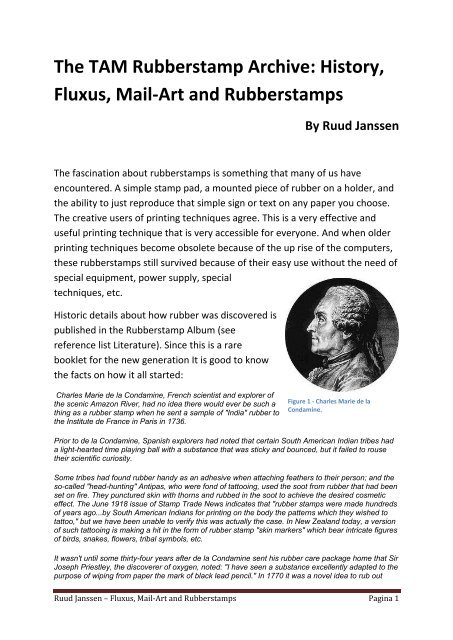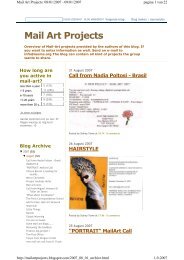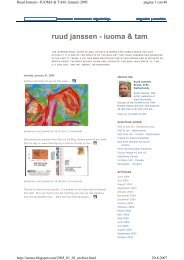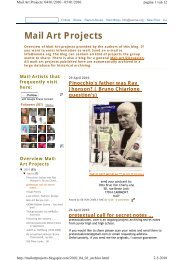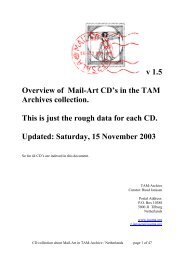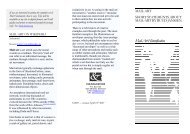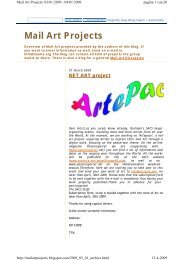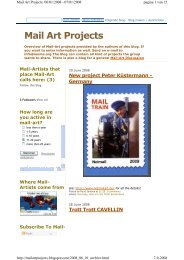The TAM Rubberstamp Archive - A Mail Artist's Anthology
The TAM Rubberstamp Archive - A Mail Artist's Anthology
The TAM Rubberstamp Archive - A Mail Artist's Anthology
Create successful ePaper yourself
Turn your PDF publications into a flip-book with our unique Google optimized e-Paper software.
<strong>The</strong> <strong>TAM</strong> <strong>Rubberstamp</strong> <strong>Archive</strong>: History,<br />
Fluxus, <strong>Mail</strong>-Art and <strong>Rubberstamp</strong>s<br />
By Ruud Janssen<br />
<strong>The</strong> fascination about rubberstamps is something that many of us have<br />
encountered. A simple stamp pad, a mounted piece of rubber on a holder, and<br />
the ability to just reproduce that simple sign or text on any paper you choose.<br />
<strong>The</strong> creative users of printing techniques agree. This is a very effective and<br />
useful printing technique that is very accessible for everyone. And when older<br />
printing techniques become obsolete because of the up rise of the computers,<br />
these rubberstamps still survived because of their easy use without the need of<br />
special equipment, power supply, special<br />
techniques, etc.<br />
Historic details about how rubber was discovered is<br />
published in the <strong>Rubberstamp</strong> Album (see<br />
reference list Literature). Since this is a rare<br />
booklet for the new generation It is good to know<br />
the facts on how it all started:<br />
Charles Marie de la Condamine, French scientist and explorer of<br />
the scenic Amazon River, had no idea there would ever be such a<br />
thing as a rubber stamp when he sent a sample of "India" rubber to<br />
the Institute de France in Paris in 1736.<br />
Figure 1 - Charles Marie de la<br />
Condamine.<br />
Prior to de la Condamine, Spanish explorers had noted that certain South American Indian tribes had<br />
a light-hearted time playing ball with a substance that was sticky and bounced, but it failed to rouse<br />
their scientific curiosity.<br />
Some tribes had found rubber handy as an adhesive when attaching feathers to their person; and the<br />
so-called "head-hunting" Antipas, who were fond of tattooing, used the soot from rubber that had been<br />
set on fire. <strong>The</strong>y punctured skin with thorns and rubbed in the soot to achieve the desired cosmetic<br />
effect. <strong>The</strong> June 1918 issue of Stamp Trade News indicates that "rubber stamps were made hundreds<br />
of years ago...by South American Indians for printing on the body the patterns which they wished to<br />
tattoo," but we have been unable to verify this was actually the case. In New Zealand today, a version<br />
of such tattooing is making a hit in the form of rubber stamp "skin markers" which bear intricate figures<br />
of birds, snakes, flowers, tribal symbols, etc.<br />
It wasn't until some thirty-four years after de la Condamine sent his rubber care package home that Sir<br />
Joseph Priestley, the discoverer of oxygen, noted: "I have seen a substance excellently adapted to the<br />
purpose of wiping from paper the mark of black lead pencil." In 1770 it was a novel idea to rub out<br />
Ruud Janssen – Fluxus, <strong>Mail</strong>-Art and <strong>Rubberstamp</strong>s Pagina 1
(hence the name rubber) pencil marks with the small cubes of rubber, called "peaux de negres" by the<br />
French. Alas, the cubes were both expensive and scarce, so most folks continued to rub out their<br />
errors with bread crumbs. Rubber limped along since attempts to put the substance to practical use<br />
were thwarted by its natural tendency to become a rotten, evil-smelling mess the instant the<br />
temperature changed.<br />
Enter Charles Goodyear. Upon hearing of the unsolvable rubber dilemma (from the Roxbury Rubber<br />
Company), Goodyear became obsessed with solving the whole sticky question once and for all.<br />
During his lifetime, Goodyear was judged to be a crackpot of epic proportions. Leaving his hardware<br />
business, he began working on the problem in his wife's kitchen, spending hours mixing up bizarre<br />
brews of rubber and castor oil, rubber and paper, rubber and salt, rubber and heaven knows what.<br />
Daily life intruded on his experiments in the form of recurring bankruptcy and sporadic imprisonment<br />
for failure to pay his debts. At one point, Goodyear actually sold his children’s' school books for the<br />
cash required to embark on the next experiment. Goodyear's persistence and single-mindedness were<br />
legion.<br />
In 1839 while fooling around in a kitchen, Goodyear accidentally dropped some rubber mixed with<br />
sulphur on top of a hot stove. Instead of turning into a gooey mess, the rubber "cured." It was still<br />
flexible the next day. <strong>The</strong> process, involving a mixture of gum elastic, sulphur, and heat was dubbed<br />
vulcanization, after Vulcan, the Roman god of fire. Vulcanized, rubber lost its susceptibility to changes<br />
in temperature. <strong>The</strong> discovery paved the way for hundreds of practical applications of rubber. In June<br />
1844, Goodyear patented for his process. Never one to rest on his laurels, Goodyear turned his<br />
formidable energies to developing a multiplicity of uses for rubber. <strong>The</strong>se continuing experiments were<br />
costly and, bless his soul, in 1860 Goodyear died two hundred thousand dollars in debt. His last words<br />
reflected the pattern of his life: "I die happy, others can get rich."<br />
Rubber stamps are considered. a marking device. Today Thomas H Brinkman, Secretary of the<br />
Marking Device Association, defines marking devices as, "<strong>The</strong> tools with which people,...add marks of<br />
identification or instruction to their work or product." <strong>The</strong> earliest roots in the marking device industry<br />
lie with early stencil makers. Many of the first rubber stamps were made by itinerant stencil makers.<br />
Since both were marking devices it was a compatible combination. <strong>The</strong> years from 1866 onward were<br />
peppered with the establishment of new stamp companies. Some were stencil makers adding stamps<br />
to their repertoire while others focused entirely on making rubber stamps.<br />
J.F.W. Dorman is said to have been the first to actually<br />
commercialize the making of rubber stamps. He started as a<br />
sixteen-year-old traveling stencil salesman in St. Louis and<br />
opened his first business in Baltimore in 1865. In 1866 he<br />
learned the technique of making rubber stamps from an<br />
itinerant actor who claimed he learned the skills from the<br />
inventor. Dorman made his first stamps under cover of night<br />
with his wife's assistance in an effort to keep the process a<br />
secret. Dorman was an inventor, and his contributions to the<br />
industry were numerous. His eventual specialty was the<br />
manufacture of the basic tools of the trade - the vulcanizer.<br />
His company continues in business today.<br />
<strong>The</strong> first stamp-making outfit ever exported from the U.S. to a<br />
Figure 2 - A vulcanizer.<br />
foreign country was shipped by R.H.Smith Manufacturing<br />
Company to Peru in 1873. Back on the home front,<br />
companies continued to spring up. In 1880 there were fewer<br />
than four hundred stamp men, but by 1892 their ranks had expanded to include at least four thousand<br />
dealers and manufacturers. An amazing number of these first companies are still in business today,<br />
frequently under their original names or merged with others whose roots lie in the mid and late 1880's.<br />
It was a small, tight knit industry, characteristics which it retains today. <strong>The</strong> longevity of the companies<br />
is no more astounding than the attitude of the stamp men themselves. Once in the business, people<br />
tended to stay loyal to it. During our research, we were amazed at the number of people who had<br />
spent forty or fifty or more happy years in the industry.<br />
Ruud Janssen – Fluxus, <strong>Mail</strong>-Art and <strong>Rubberstamp</strong>s Pagina 2
Early stamp makers tend to be colorful, and many frontier like exploits dot the landscape. Louis K<br />
Scotford and his companion Will Day set off across Indian Territory to the settlements in Texas<br />
carrying their stamp-making equipment in an old lumber wagon. <strong>The</strong> country was wild and rugged in<br />
1876, frequented by bandits and Indians. L.K. and Will solicited orders during the day, made the<br />
stamps at night, and delivered the following day in time for the intrepid pair to harness up and head<br />
out once again. It was a romantic adventure and not unprofitable. At the end of their three-thousand<br />
mile trek, the two returned to St. Louis with two twenty-five pound shot bags filled with silver dollars.<br />
Charles Klinkner, who established his West Coast stamp house in 1873, would have been the pride of<br />
any modern day publicity agent. Klinkner was prone to calling attention to his wares in startling,<br />
unorthodox ways. He rode around San Francisco and Oakland in a little red cart drawn by a donkey<br />
rakishly dyed a rainbow of colors. To make his stamps sound like something extra special, he<br />
advertised them as "red rubber stamps", and people were convinced that it meant something. At the<br />
time, almost all stamps were made from red colored rubber. Ah, the power of suggestion.<br />
After years of talk and numerous attempts to organize, the industry formed a national trade<br />
organization in 1911. M.L. Willard and Charles F Statford, who had worked long and hard toward<br />
organizing the stamp men, saw their work bear fruit when the first marking-device trade convention<br />
took place at the LaSalle Hotel in Chicago June 20th 1911. It was the beginning of a new era and<br />
even pioneer stamp personage. B.B. Hill, the father of the "mechanical hand stamp", then eighty years<br />
old with fifty years in the business behind him, was on hand to hear the International Stamp Trade<br />
Manufacturers Association voted into existence. Today the organization is known as the Marking<br />
Device Association and is headquartered in Evanston, Illinois.<br />
A number of trade journals served the industry: Stamp Manufacturer's journal, Stamp Trade News,<br />
Marking Devices Journal, and now Marking industry magazine. Since 1907, the publications have<br />
reflected serious industry discussions about trade ethics, price controls, planning by scientific<br />
management, and marketing, mixed with folksy anecdotes about who was playing which sport for<br />
charity and tidbits about a 175-pound swordfish off the Californian coast. Pricing information was<br />
colorful on occasion as witnessed by this quote from the February 1909 Stamp Trade News: "No blood<br />
flows from a turnip nor does wealth flow from rubber made into rubber stamps at ten cents per line."<br />
<strong>The</strong> same issue proffered a real gem from a column called "Pen Points" - "Rubber stamps made while<br />
you wait is not a good sign to hang out. It makes it look too easy."<br />
<strong>The</strong> rubberstamp used as an tool for artists is also described in the<br />
<strong>Rubberstamp</strong> Album. <strong>The</strong> details are also available online though:<br />
http://www.customstampsonline.com/Pages/History02.aspx . Essential<br />
historical facts though are a must for any artist using rubber stamps. For art<br />
critics is is essential because they can determine who did what first. Some<br />
artists create new ways and some are inspired by history. In the network you<br />
encounter both.<br />
<strong>The</strong> historical facts:<br />
One of the first to integrate the rubber stamp<br />
in works of art was German artist/poet Kurt<br />
Schwitters, who dubbed his art activities<br />
"Mertz" (from a scrap of paper with the word<br />
KOMMERTZ used in one of his early<br />
collages. "Mertz" applies to the bulk of<br />
Schwitters work, and not exclusively to the<br />
pieces incorporating rubber stamps. As early<br />
as 191 he created "Merz rubber stamp<br />
drawings", which were an amalgam of pasted<br />
Figure 3 - Kurt Schwitters<br />
Ruud Janssen – Fluxus, <strong>Mail</strong>-Art and <strong>Rubberstamp</strong>s Pagina 3
its of paper, drawings and stamp impressions made with common, functional stamps that bore<br />
phrases such as BELEGEXEMPLAR (Review Copy) and BEZAHLT (Paid). A hefty art tome entitled<br />
"Kurt Schwitters" written by Werner Schmalenbach shows four examples of Schwitter's works<br />
containing rubber stamp impressions. Probably the first book of rubber stamp works was Schwiter's<br />
"Sturm Bilderbuch IV" published in Berlin in 1920, which contains fifteen poems and fifteen rubber<br />
stamp drawings.<br />
An article in the Special Catalogue Edition of La Mamelle's "FRONT" written by Ken Freidman and<br />
Georg M. Gugelberger, dates the introduction of the stamp into contemporary art to Ben Vautier's use<br />
of a rubber stamp (LART CEST) in his works in 1949.<br />
Both German artist Dieter Roth and French artist Arman began using stamps heavily in their works in<br />
the 1950's. From the late 1950's onward the number of artists and writers using stamps in their works<br />
expanded tremendously and the range of works widened to include not only hand-stamped. limited<br />
edition books and prints but sculptures, paintings, and multiples as well. In 1968, Multiples. Inc (New<br />
York) published a project called "Stamped Indelibly" containing work by such other well known artists<br />
such as Marisol, Oldenburgh, Warhol Indiana and others.<br />
Much of the stamp activity in the 1960's stemmed from the Fluxus movement, a loose-knit<br />
international avant group somewhat Dada in spirit, whose<br />
participants included Joseph Bueys, Robert Filliou, Ken<br />
Freidman, Dick Higgins, Yoko Ono and Ben Vautier.<br />
Freidman and Vautier are said to have published in 1966<br />
the first multiple to include rubber stamps as physical<br />
objects. Published by Fluxus, it was called "Fluxpost Kit"<br />
and contained stamps by both artists. Even a partial listing<br />
of artists involved with stamp activities during the last<br />
several decades is a long one: Charles Amirkhanian,<br />
Anna Banana, George Brecht, Fletcher Coop, Herve<br />
Fischer, Bill Gaglione, J H Kochman, Carol Law, Emmet<br />
Williams, and on. And then, of course, is Saul Steinberg.<br />
Stienberg's work frequently appears in <strong>The</strong> New Yorker<br />
Magazine, and has incorporated rubber stamps into his<br />
work for years, sometimes stamped in ink, sometimes in<br />
oil paint. A major Steinberg exhibition organized by the Figure 4 - Ben Vautier 1990<br />
Whitney Museum of American Art contained numerous<br />
pieces dotted with the rubber stamps Steinberg considers personal. Since little has been written on<br />
rubber stamps and the artist, two books are especially important to know about. According to the<br />
Freidman/Gugelberger article in FRONT, Czech artist J H Kocman's book "Stamp Activity", published<br />
in a limited, thirty-edition copy in 1972, was "the first true anthology of stamps and their use by artists".<br />
Herve Fischer's book "Art et Communication Marginale, Tampons d'artistes" was published by<br />
Editions (Paris) in 1974., devotes almost two hundred pages to whole stamp works or selections from<br />
artist's collections. In most cases, brief biographical information about the artist is also supplied.<br />
In this text from the Rubber Stamp Album they have indicated very little about<br />
the influences of the Dada movement. This movement in the beginning of the<br />
previous century had a major impact to the art world and Kurt Schwitters was<br />
only one of the players there. <strong>The</strong> working with fonts and letters in the Dada<br />
work preceded the use of rubberstamps. But especially here the adding of a<br />
quick print with a rubberstamp was initiated.<br />
Ruud Janssen – Fluxus, <strong>Mail</strong>-Art and <strong>Rubberstamp</strong>s Pagina 4
Figuur 5 - Dada 6 (Bulletin Dada),<br />
ed. Tristan Tzara (Paris 1920) -<br />
cover<br />
An extensive text on the Dada-movement in New<br />
York, mentioning the impact of Tzara and Picabia can<br />
be found on:<br />
http://www.artic.edu/reynolds/essays/hofmann2.php<br />
and to make a clearer context for the use of<br />
rubberstamps in a historical perspective a selection is<br />
included here:<br />
From: Documents of Dada and Surrealism: Dada and Surrealist<br />
Journals in the Mary Reynolds Collection.<br />
<strong>The</strong> same year Tzara introduced his review Dada in Zurich, related<br />
activities took place in New York. Not unlike Zurich, New York had<br />
become a refuge for European artists seeking to escape the war. For<br />
artists such as Marcel Duchamp and Francis Picabia, the American<br />
city presented great potential and artistic opportunity. Soon after<br />
arriving there in 1915, Duchamp and Picabia met the American artist Man Ray. By 1916, the three<br />
men had become the center of radical anti-art activities in New York. While they never officially labeled<br />
themselves Dada, never wrote manifestos, and never organized riotous events like their counterparts<br />
in Europe, they issued similar challenges to art and culture. As Richter recalled, the origins of Dadaist<br />
activities in New York "were different, but its participants were playing essentially the same anti-art<br />
tune as we were. <strong>The</strong> notes may have sounded strange, at first, but the music was the same."[14]<br />
<strong>The</strong> anti-art undercurrents brewing in New York provided an ideal climate for Picabia's provocative<br />
journal 391. Published over a period of seven years, 391 is the longest running journal in the Mary<br />
Reynolds Collection. <strong>The</strong> magazine first appeared in Barcelona in 1917, and was modeled after the<br />
pioneering journal 291, which was published under the auspices of the photographer and dealer Alfred<br />
Stieglitz.[15] Picabia was able to put out four issues of 391 in Barcelona with the support of some likeminded<br />
expatriates and pacifists.<br />
Although 391's corrosive spirit was only just emerging in these early issues, the anarchic attitude that<br />
would later define the magazine and its editor is already apparent. <strong>The</strong>se first issues introduce, for<br />
example, a section devoted to a series of bogus news reports. As Gabrielle Buffet-Picabia recalled,<br />
this feature began as a mere joke and "quickly degenerated in subsequent issues into a highly<br />
aggressive system of assault, defining the militant attitude which became characteristic of 391."[16]<br />
<strong>The</strong>se early issues include literary works by poet Max Jacob, painter Marie Laurencin, and Georges<br />
Ribemont-Dessaignes, as well as by Picabia, and feature cover illustrations of absurd machines<br />
designed by Picabia.<br />
By the time Picabia took 391 to New York at the end of 1917, the magazine had assumed a decidedly<br />
assertive and irreverent tone. <strong>The</strong> New York editions of 391, issues five through seven, celebrate<br />
Picabia's nihilistic side and his love of provocation and nonsense. Buffet-Picabia had this to say about<br />
391:<br />
It remains a striking testimonial to the revolt of the spirit in defense of its rights, against and<br />
in spite of all the world's commonplaces...Without other aim than to have no aim, it<br />
imposed itself by the force of its word, of its poetic and plastic inventions, and without<br />
premeditated intention it let loose, from one shore of the Atlantic to the other, a wave of<br />
negation and revolt which for several years would throw disorder into the minds, acts,<br />
works, of men.[17]<br />
Picabia's three New York issues feature contributions by collector Walter Arensberg, painters Albert<br />
Gleizes and Max Jacob, and composer Edgar Varèse.<br />
Ruud Janssen – Fluxus, <strong>Mail</strong>-Art and <strong>Rubberstamp</strong>s Pagina 5
While Picabia was involved primarily with the group of artists surrounding Alfred Stieglitz and with the<br />
publication of 391, Duchamp made connections with Arensberg, through whom he became involved in<br />
the Society of Independent Artists. It was this organization, interested in sponsoring jury-free<br />
exhibitions, that gave Duchamp the idea for <strong>The</strong> Blind Man—a publication that would invite any writer<br />
to print whatever he or she wanted. <strong>The</strong> inaugural issue, published on April 10, 1917 by Duchamp and<br />
writer Henri-Pierre Roché, has submissions by poet Mina Loy, Roché, and artist Beatrice Wood.<br />
Emphasizing the informal editorial policies and uncertain future of <strong>The</strong> Blind Man, the front cover<br />
proclaims, "<strong>The</strong> second number of <strong>The</strong> Blind Man will appear as soon as YOU have sent sufficient<br />
material for it." When this hastily published first issue came out, the editors realized that they had<br />
forgotten to print the address of the magazine on the cover. To remedy this, a rubber stamp was<br />
created and used to imprint this information on the front cover of each issue.[18]<br />
Figure 6 - <strong>The</strong> Blind Man 1. eds.<br />
Marcel Duchamp, Beatrice Wood,<br />
Henri-Pierre Roché - 1917 New York<br />
Since Duchamp and Roché were not American citizens, and<br />
therefore faced possible conflicts with authorities, Beatrice Wood<br />
stepped forward to assume responsibility for <strong>The</strong> Blind Man.<br />
Because her father subsequently protested her involvement (due to<br />
the periodical's content), it was decided that rather than making it<br />
available to mainstream audiences through newsstands, <strong>The</strong> Blind<br />
Man would be distributed by hand at galleries.[19]<br />
<strong>The</strong> second issue of <strong>The</strong> Blind Man came out two months after the<br />
first,[20] following the opening of the Society of Independent Artists'<br />
1917 exhibition and the rejection of Duchamp's infamous entry<br />
Fountain, a urinal that the artist signed with a fictitious name and<br />
anonymously submitted as sculpture. This issue features Stieglitz's<br />
photograph of Fountain and the editorial "<strong>The</strong> Richard Mutt Case,"<br />
which discusses the rejection of Duchamp's entry. Also included in<br />
this issue were contributions by Arensberg, Buffet, Loy, and<br />
Picabia, among others.<br />
While <strong>The</strong> Blind Man had caught the attention of the New York art<br />
community, a wager brought an early end to the magazine. In a<br />
very Dada gesture, Picabia and Roché had set up a chess game to decide who would be able to<br />
continue publishing his respective magazine. Picabia, playing to defend 391, was triumphant: Roché<br />
and Duchamp were forced to discontinue<br />
<strong>The</strong> Blind Man.[21]<br />
Following the early demise of <strong>The</strong> Blind<br />
Man, Duchamp launched another shortlived<br />
magazine. Edited by Duchamp,<br />
Roché, and Wood, Rongwrong (May 1917)<br />
carries contributions by Duchamp and<br />
others within Arensberg's circle, as well as<br />
documentation of the moves from Picabia's<br />
and Roché's infamous chess game.<br />
Duchamp intended the title of the magazine<br />
to be Wrongwrong, but a printing error<br />
transformed it into Rongwrong. Since this<br />
mistake appealed to Duchamp's interest in<br />
chance happenings, he accepted the title.<br />
<strong>The</strong> appearance of the journal New York<br />
Dada (April 1921) ironically marked the<br />
beginning of the end of Dada in New York.<br />
Figure 7 - <strong>The</strong> Blind man 2, eds Marcel Duchamp, Beatrice Wood,<br />
Henri-Pierre Roché - 1997 New York<br />
Created by Duchamp and Man Ray, this magazine would be the only New York journal that would<br />
claim itself to be Dada. Wishing to incorporate "dada" in the title of this new magazine, Man Ray and<br />
Duchamp sought authorization from Tzara for use of the word. In response to their tongue-in-cheek<br />
Ruud Janssen – Fluxus, <strong>Mail</strong>-Art and <strong>Rubberstamp</strong>s Pagina 6
equest Tzara replied, "You ask for authorization to name your periodical Dada. But Dada belongs to<br />
everybody."[22] In addition to printing Tzara's response in its entirety, this first and only issue also<br />
carried a cover designed by Duchamp, photography by Man Ray, poetry by artist Marsden Hartley, as<br />
well as several illustrations. As with so many self-published artistic journals, this first issue was neither<br />
distributed nor sold, but circulated among friends with the hope that it would generate a following. New<br />
York Dada, however, was unable to ignite any further interest in Dada. By the end of 1921, Dada<br />
came to an end in New York and its original nucleus departed for Paris, where Dada was enjoying its<br />
final incarnation.<br />
Originally the rubberstamp was made for a special user-group<br />
of people. <strong>The</strong> decision makers that had access to their stamp<br />
and by using it, authorized certain decisions. In the<br />
bureaucracy an essential part. <strong>The</strong> art-forms that avoided the<br />
settled art world off course embraced the possibilities to use<br />
their own rubberstamps and to ridicule certain hierarchies in<br />
these closed circles.<br />
Figure 8 - One of the<br />
hand carved stamps<br />
in the archive – by<br />
Eberhard Seifried,<br />
Germany.<br />
<strong>The</strong> <strong>Rubberstamp</strong> was originally focused on text. In the <strong>Mail</strong>-Art and Fluxus<br />
world the texts people wanted to print were different from what ‘normal’<br />
people would print. Creativity always leads to strange results. To make a<br />
statement and to reproduce it was in the 60-ies and 70-ies not easy. <strong>The</strong> copy<br />
machine was not everywhere available, and quickly reproducing a text or a<br />
document even printing texts on paper and envelopes had become easy with<br />
that rubberstamp.<br />
As a young boy I saw my father using a name stamp for his correspondence.<br />
And from my saved money then I already ordered my own name stamp when I<br />
was only 14 years old. Discovering the <strong>Mail</strong>-Art network in 1980 (I was only 21<br />
years old) was opening up my learning process of how to explore the new ways<br />
of communicating.<br />
Ruud Janssen – Fluxus, <strong>Mail</strong>-Art and <strong>Rubberstamp</strong>s Pagina 7
Figure 9 - Sample of one of the address<br />
lists of the archive<br />
In 1983 I decided to collect the prints of <strong>Mail</strong>-<br />
Artists I was in contact with. That was the start of<br />
sending out numbered stamp sheets, that after the<br />
start began to come in. Every sheet was given a<br />
printing date. Also the sheets became a unique<br />
number so I could keep track of them. <strong>The</strong> lay-out<br />
and text of the sheet has slightly been updated<br />
over the years. Seeing a selection of the archive<br />
that goes over the almost 30 years it exists will<br />
explain this development best. Besides the many<br />
mail-art projects I have done, this one has been<br />
going on for decades now. Almost every mail-artist<br />
I was in contact with must have received such a<br />
sheet. To broaden the scope of the collection I<br />
also sent out collage stamp sheets. <strong>The</strong> same structure but more than one<br />
mail-artist would work on the paper. It also meant the receiver of a blank sheet<br />
could choose another artists that I didn’t know and that way my network would<br />
enlarge quite rapidly. Also the adding of rubberstamp prints to the ones<br />
another artists placed on the sheet gives the networking element a new<br />
dimension.<br />
Documenting the complete collection started to become a problem. In the<br />
beginning I had hand typed lists. Every month that new contributions came in I<br />
added them to the list on a typewriter. <strong>The</strong>y were reproduced several times<br />
and distributed into the network all the time. Some of them also ended up with<br />
John Held Jr. in USA, and he even eventually sent them to the MoMa <strong>Mail</strong>-Art<br />
collection. Because of my computer skills I also made a database in the 80-ies in<br />
which I kept the details of the collection and participating artists. <strong>The</strong> lists<br />
produced then were sorted by country and using the program “Reflex” , that<br />
time an advanced relational database, I was able to report in more details. That<br />
documentation was printed and bound into booklets which I know and then<br />
sent into the network too. <strong>The</strong> long historic address list came in handy for lots<br />
of other mail-artists that wanted to explore their network. It grew into a<br />
booklet of over 40 pages. Thousands of addresses and also countries that<br />
vanished (USSR, East-Germany, Yugoslavia, etc..) and were newly created<br />
(Croatia, Russia, Latvia, etc..). At a certain point after 2000 the number of<br />
Ruud Janssen – Fluxus, <strong>Mail</strong>-Art and <strong>Rubberstamp</strong>s Pagina 8
sheets that came in just grew too rapidly and this database wasn’t continued.<br />
For a complete list of all the sheets serious work is needed. <strong>The</strong> number of<br />
sheets in the collection is ten thousands.<br />
After documenting the collection, exhibiting was the next phase. At the time I<br />
was looking for such a place John Held Jr. had<br />
started to work with Bill (Picasso) Gaglione in<br />
San Francisco and they were doing these<br />
wonderful exhibitions in the Stamp Art<br />
Gallery. In 1996 they asked me if I wanted to<br />
exhibit a part of the <strong>TAM</strong> <strong>Rubberstamp</strong><br />
<strong>Archive</strong> there. Instead of sending them the<br />
sheets I did a special project that all new<br />
sheets would go straight to San Francisco, and<br />
that I wouldn’t come myself for the opening<br />
but instead would give a lecture about <strong>TAM</strong>,<br />
the Stamp <strong>Archive</strong>, and what people didn’t<br />
know in advance, I conducted lots of mail-<br />
interviews with people I met during that Journey. See for more details the link<br />
list as an appendix of this essay. <strong>The</strong> catalogue of this first exhibition was<br />
produced by the Stamp Art Gallery and contained reproduction of all the<br />
sheets. I was in San Francisco and surroundings for two weeks and met lots of<br />
people I am very happy<br />
to know (see report on:<br />
http://www.iuoma.org/r<br />
eis_usa.html) .<br />
When John & Bill were<br />
in Europe for one of<br />
their Fake Picabia Tours<br />
they also visited Tilburg.<br />
Bill tried to stamp as<br />
much of the original<br />
stamps as possible<br />
during the short stay<br />
Figure 10 - Poster of the exhibit of the <strong>TAM</strong>-<br />
<strong>Rubberstamp</strong> <strong>Archive</strong> in San Francisco (1996)<br />
Figure 11 - Me, John Held Jr. and Bill (Picasso) Gaglione - Showing the original<br />
booklet with the stamp prints – Tilburg – Netherlands – 1995.<br />
Ruud Janssen – Fluxus, <strong>Mail</strong>-Art and <strong>Rubberstamp</strong>s Pagina 9
they had in my apartment. He printed quite a lot and eventually that collection<br />
was quite well documented in another publication they created.<br />
<strong>The</strong> collection of the <strong>TAM</strong> <strong>Rubberstamp</strong> <strong>Archive</strong> focuses mainly on these stamp<br />
sheets. Rubber itself loses its printing function as soon as the rubberstamp isn’t<br />
used anymore. <strong>The</strong> oil that the special rubberstamp ink consists prevents the<br />
rubber from getting hard. Once it does get hard, the quality of<br />
the stamp goes backwards rapidly and archiving the rubber is<br />
just archiving the artifact. <strong>The</strong> message, text or image can’t be<br />
reproduced anymore. That is the basic reason for starting the<br />
archive. To preserve on paper the prints of all those users and<br />
to keep the images alive for now almost 3 decades.<br />
In the 90-ies I also was in close contact with some of the<br />
rubberstamp firms that have emerged in both Europe and the<br />
USA. Two times the magazine <strong>Rubberstamp</strong>madness sent a reporter to me to<br />
do interview that was published in this magazine. At Stempel-Mekka (Germany)<br />
I even gave workshops eraser carving and to my surprise found Anna Banana to<br />
be there as well. Wolfgang Hein allowed me to use his walking rubberstamp in<br />
the logo that was produced in an edition of 150 to make the archive known and<br />
also to send out as a gift to the many people that kept sending in stamp sheets<br />
to the archive.<br />
Since 1996 I traveled intensively to Heidelberg in Germany.<br />
About 7 times a year I was in this beautiful city to meet with<br />
Litsa Spathi. Litsa is a talented painter and also conceptual<br />
artists who focuses on Object books and also produces lots<br />
of Fluxus Poetry. In 2003 she had the idea to combine the<br />
three words Fluxus , Heidelberg and Center into one Institute<br />
and that was the start of the Fluxus Heidelberg Center (see<br />
www.fluxusheidelberg.org). In a lot of performances the<br />
rubberstamps also were included but life in the new times<br />
involve a lot of new tools that are integrated in the new<br />
Fluxus too. We knew then that life is a constant Flux. <strong>The</strong><br />
Figure 12 -<br />
<strong>Rubberstamp</strong> made<br />
in an edition of 150<br />
and distributed into<br />
the network.<br />
Figure 13 - One of the<br />
Stamps used in<br />
Performances for Fluxus<br />
Heidelberg Center<br />
Fluxus Heidelberg Center is currently located in Breda (Netherlands) and in<br />
Athens (Greece).<br />
Ruud Janssen – Fluxus, <strong>Mail</strong>-Art and <strong>Rubberstamp</strong>s Pagina 10
All stamp performances from the beginning are documented in the book that<br />
was published to document the first years of the center (see for all details :<br />
http://www.lulu.com/content/4108181) In the 251 pages also a lot of photos<br />
are included. For printing the book we used also the newest possibilities. Ondemand<br />
publishing and distribution of the book. Even a complete color version<br />
is available for libraries and collectors (see:<br />
http://www.lulu.com/content/3996203).<br />
In 2004 A 2 nd exhibition of the rubberstamp archive was<br />
done. In Moscow this time on invitation of Gik Juri. <strong>The</strong><br />
location was the famous L-Gallery in centre of Moscow. <strong>The</strong><br />
concept this time was the same. Sheets would go directly to<br />
Moscow. Unfortunately because of too many travel plans and<br />
differences in opinion I never made it to Moscow. Till today<br />
these sheets never got returned to the archive but are still in<br />
the collection of Gik Juri. When I requested him to return the<br />
Figure 14 – Printed<br />
catalog Moscow<br />
Exhibition<br />
sheets for the archive years later he claims to have lost them. <strong>The</strong> catalog this<br />
time was made in digital form. A CD with videos, digital scans of every sheets<br />
and even video images of how the show was presented on the Russian<br />
television. A hardcopy of the text and catalogue is also available at:<br />
http://www.lulu.com/content/1862885<br />
Figure 15 - Cover of the CD produced for the<br />
exhibition in Moscow at the L-Gallery.<br />
In 2005 some major changes<br />
happened in my life. Moved out of<br />
Tilburg, got married, started a new<br />
job in Breda. <strong>The</strong> complete archive<br />
travelled with me in boxes and has<br />
now a lot more space. It still is a private collection. Because of my work with<br />
Internet and the digital environments I place a lot of information online and in<br />
that way have made a lot of my archive, texts and art available in digital<br />
format. Even the printed catalogue that contains part of the documents of the<br />
exhibition is now available on the Internet and can be ordered as a book as<br />
well.<br />
Ruud Janssen – Fluxus, <strong>Mail</strong>-Art and <strong>Rubberstamp</strong>s Pagina 11
After some doubts whether to continue the growth of the archive it was<br />
decided to continue the sending out of stamp sheets. This time with the Breda<br />
Address. Over the years I kept lists of how many sheets were sent out, but the<br />
number on the sheets give a clear hint on how many sheets have been sent<br />
out. A lot never returned. I sometimes know also the reason. Since every sheets<br />
is hand stamped some even started to collect the sheets. Every sheet is dated<br />
as well, so they are not just simple copies but hand stamped by me. I guess the<br />
collage stamp sheets also ended up in some collections of other mail-artists. On<br />
a documentation of a mail-art show I even saw a sheets sent in as a<br />
contribution.<br />
<strong>The</strong> last years there are changes<br />
visible. It was predicted that the mail<br />
art network would decrease in<br />
volume because of the new<br />
electronic communication tools. In<br />
the beginning of this new millennium<br />
that even happened. But with<br />
learning how to use the computer in<br />
communication, the ability to digitize<br />
and publish your images and videos<br />
Figure 16 - Special group on the IUOMA network discussing<br />
and exchanging Rubber Stamp Art - 2010<br />
online, the network found each other again and the old generation of<br />
networkers discovered the new networkers. On the social network I created for<br />
IUOMA in November 2008 (International Union of <strong>Mail</strong>-Artists , see:<br />
http://iuoma-network.ning.com/) the number of mail-artists online has<br />
increased to almost 1,000. Also artists that discover the concept of <strong>Mail</strong>-Art<br />
online and only then start to send out the traditional mail. Also new and old<br />
Fluxus artists have discovered the Internet and have used it a lot. In the <strong>Mail</strong>-<br />
Interviews with Dick Higgins, Ken Friedman and Alison Knowles questions and<br />
answers also went back and forth in a digital way.<br />
In 2010 a new exhibition that will show a part of the <strong>TAM</strong> <strong>Rubberstamp</strong><br />
archive. This time in New York at the Mary Stendhal Gallery – NYC. Part of the<br />
“Greetings from Daddaland: Fluxus, <strong>Mail</strong> Art and Rubber stamps” curated by<br />
John Held Jr. and Picasso Gaglione. In the many projects I did I also crossed a<br />
lot of paths with Fluxus artists and Fluxus-related artists. A lot of people that<br />
Ruud Janssen – Fluxus, <strong>Mail</strong>-Art and <strong>Rubberstamp</strong>s Pagina 12
associate themselves with mail-art have sent in stamp sheets with their specific<br />
use of rubberstamp on that small piece of paper. <strong>The</strong>re was no time to have a<br />
restart of the concept to send in sheets directly to the Gallery. So this time a<br />
special selection of sheets documenting how Rubber has been used in the last<br />
three decades. Off course also focused on some of the names that are<br />
associated with that large circle of friends that have gathered around the<br />
curators of the show: John held Jr. and Picasso (Bill) Gaglione. <strong>The</strong> exhibited<br />
part of the collection will include artists like: BuZ blurr, M.B. Corbett, Litsa<br />
Spathi, John M. Bennett, Dick Higgins, Robert Rehfeldt, Rea Nikonova, Joseph<br />
W. Huber, Robert Rocola, Jan Cremer, Robin Crozier, Bern Porter, Dieter<br />
Albrecht, John Held Jr. Picasso Gaglione, H.R. Fricker, David Cole, John Evans,<br />
Carlo Pittore, and to be short, quite a large list of <strong>Mail</strong>-Artists that are wellknown<br />
to the network. All sheets that were originally sent in for the Stamp Art<br />
Gallery exhibition will now be in New York.<br />
It is typical that the <strong>Rubberstamp</strong> has such an important place in both <strong>Mail</strong>-Art<br />
and Fluxus. If you follow the life around you to and reflect it in your art there is<br />
always the time factor and the fun factor. A rubberstamp is easy to make, fast<br />
to make, always available in any place. It can used for so many purposed and is<br />
such a handy multifunctional tool that was originally just meant for<br />
bureaucrats. <strong>The</strong> fun of rubberstamps is indeed that the owner can change. A<br />
lot of rubberstamps are designed and made by the artists but also exchanged<br />
or sent as a gift. All these images go around the globe and the temporary<br />
owner of the set can print them as long as he/she has access. <strong>The</strong>re are even<br />
special projects done where a rubberstamp is travelling the globe and where<br />
the temporary user can use the rubberstamp for just a month. Some original<br />
rubberstamps of the <strong>Archive</strong> have found new homes as well. Or some eraser<br />
carved stamps were made on location so they even reflect the situation one is<br />
in. Typical tools for both a Fluxus- or a <strong>Mail</strong>-Artists. Who is to say whether an<br />
artist fits in just one category. Life keeps changing, and I know I am always<br />
going with the new things I encounter.<br />
Most Samples of how <strong>Rubberstamp</strong>s can/are used in both <strong>Mail</strong>-Art and Fluxus<br />
are documented in several books. I have added a small list of reference books<br />
that tell quite a bit. <strong>The</strong> <strong>TAM</strong> <strong>Rubberstamp</strong> archive is a growing collection.<br />
Every week new sheets come in and empty sheets are sent out. As long as<br />
Ruud Janssen – Fluxus, <strong>Mail</strong>-Art and <strong>Rubberstamp</strong>s Pagina 13
ubberstamps are used by artists, they will eventually get a sheet one way or<br />
the other. Analyzing the collection is something that still needs to be done.<br />
Showing parts of the collection to a broader public is the start.<br />
Ruud Janssen , March 21, 2010.<br />
Ruud Janssen was born at Tilburg, Netherlands. He studied Technical Physics at the<br />
University in Eindhoven and Physics/Mathematics at the Teachers College in Tilburg. He<br />
became active with mail art in 1980 and organized many international mail art projects.<br />
Janssen publishes articles, magazines and booklets with his <strong>TAM</strong>-Publications. In 1988 he<br />
founded the IUOMA (International Union of <strong>Mail</strong>-Artists) Since 1983 he is the curator of the<br />
<strong>TAM</strong>-<strong>Rubberstamp</strong> <strong>Archive</strong>. In 1994 he started with his legendary <strong>Mail</strong>-Interviews which<br />
have been published as booklets and online which are now also available at the MoMa in<br />
New York. He conducted interviews with Fluxus and mail artists in different communication<br />
forms. <strong>The</strong> interviews have a new concept where the question is sent in a specific<br />
communication form and the interviewed person chooses his own way to get the answer back.<br />
This way the factor time is involved in each specific interview. In 2003 Ruud Janssen was cofounder<br />
of the Fluxus Heidelberg Center that was initiated by Litsa Spathi. Since 2005 Ruud<br />
Janssen lives in Breda, Netherlands.<br />
Literature:<br />
1. John Held Jr. – “L’arte del Timbro” edited by Baroni, Vittore, Italy. ISBN:<br />
88-86828-23-3 - AAA Edizioni. [1999]<br />
2. Herve Fischert - "Art et Communication Marginale, Tampons d'artistes"<br />
was published by Editions (Paris) in [1974].<br />
3. <strong>Rubberstamp</strong> Album by Joni K. Miller & Lowry Thompson – <strong>The</strong> complete<br />
guide to making everything prettier, weirder, and funnier. How and<br />
where to buy over 5,000 rubber stamps. And how to use them. ISBN 0-<br />
89-480-045-0 Rainbird Publishing Group - Workman Publishing, New<br />
York. [1978]<br />
4. L’art du Tampon - Expo Paris. Edited by the “Musée de la Poste” in Paris<br />
– France. [1995]<br />
5. Rubber Stamper’s Bible, Author: Francoise Read, USA , ISBN-13: 978-<br />
0715318515 , Publisher: F & W Publications [2005].<br />
6. Rubber Soul, Author: Sandra Mizumdo Posey, Publisher: Jackson<br />
University Press Mississippi [1996]<br />
7. Rubber Stamps - Klaus Groh, Edewecht, Germany, Edition des Dada<br />
Research Centre, [1983?]<br />
Ruud Janssen – Fluxus, <strong>Mail</strong>-Art and <strong>Rubberstamp</strong>s Pagina 14
Contact Details:<br />
Ruud Janssen<br />
<strong>TAM</strong>-Publications<br />
P.O. Box 1055<br />
4801 BB Breda<br />
NETHERLANDS<br />
r.janssen@iuoma.org<br />
http://www.iuoma.org<br />
Harry Stendhal<br />
Stendhal Gallery<br />
545 West 20th Street<br />
New York, NY 10011<br />
2123661549<br />
info@stendhalgallery.com<br />
http://www.stendhalgallery.com<br />
Online Details:<br />
<strong>TAM</strong>-<strong>Rubberstamp</strong> <strong>Archive</strong> : http://tamrubberstamparchive.blogspot.com/<br />
IUOMA-Network : http://iuoma-network.ning.com/<br />
<strong>Mail</strong>-Interviews : http://mailinterviews.blogspot.com/<br />
IUOMA Bookshop : http://stores.lulu.com/iuoma<br />
Ruud Janssen – Fluxus, <strong>Mail</strong>-Art and <strong>Rubberstamp</strong>s Pagina 15


